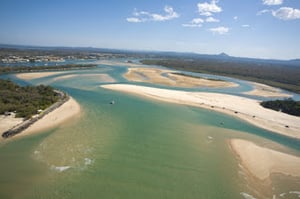 While operating your boat there will be times when you will need to enter a port in rough and challenging conditions. Although certain inlets and rivers have extreme conditions much more often than others, learning how rough weather affects the various harbors and entrances throughout your local area is necessary to operate safely.
While operating your boat there will be times when you will need to enter a port in rough and challenging conditions. Although certain inlets and rivers have extreme conditions much more often than others, learning how rough weather affects the various harbors and entrances throughout your local area is necessary to operate safely. Knowing as much information as possible prior to entering a harbor, inlet, or river in rough weather will help guard against potential dangers or impending problems. In these cases local knowledge can make the difference between a safe passage or getting you and your crew in trouble. If you are operating in an area which is new or unfamiliar to you “local knowledge” can also be gained through the use of cruising guides or Coast Pilots found in many ship stores or online.
Here are a few things you should be aware of before entering any of these areas:
- Watch where waves break. Know how far out into the channel, whether near jetties or shoals, or directly across the entrance the waves break.
- Pay close attention to how the entrance affects wave patterns. An entrance that has jetties may push waves back across an entrance where they combine with the original waves.
- Some entrances have an outer bar that breaks, and then additional breaks farther in. Others are susceptible to a large, heaving motion that creates a heavy surge as it hits rocks or structures.
- Know where the channel actually is. If shoaling has occurred, room to maneuver may be significantly reduced.
- Know the actual depths of the water. Account for any difference between actual and charted depth due to water stage, height of tide, recent rainfall, or atmospheric pressure effects.
When entering a harbor, inlet, or river you will need to pay special attention to the direction of the current and seas. The most challenging condition you can encounter is when the current opposes the seas when operating near an entrance. In this case the current will have the effect of shortening the wavelength, and increasing the wave height. This makes waves much more unstable and closer together.
 While heading into the oncoming seas, you will find that the current is coming from behind your vessel thus pushing your boat into the seas at a relatively higher speed. You can reduce this effect (which will also give more time to react between waves) by slowing your vessel, although the current is coming from behind you will still need to keep enough headway to ensure effective steering.
While heading into the oncoming seas, you will find that the current is coming from behind your vessel thus pushing your boat into the seas at a relatively higher speed. You can reduce this effect (which will also give more time to react between waves) by slowing your vessel, although the current is coming from behind you will still need to keep enough headway to ensure effective steering.When transiting an entrance, you will find that maneuvering room is often very limited. The only safe water may be found in the area that you just left. Be ready to back down and avoid the breaking crest of a wave. This situation can become critical in following seas with a head current. The waves will overtake your vessel at a higher rate and will break more often. The current will reduce your boat’s speed over the ground (SOG) which will expose your vessel to more waves. In this condition it is important to remain calm and not panic.
Remember that with all following seas, you need to stay on the back of the wave ahead. As these waves become unstable they tend to break more quickly, use extra caution to ensure that you do not go over the crest of the wave ahead. Concentrate both on the crest in front of you and the waves behind. You must keep a hand on the throttle and adjust your power continuously.




Let Us Know What You Thought about this Post.
Put your Comment Below.